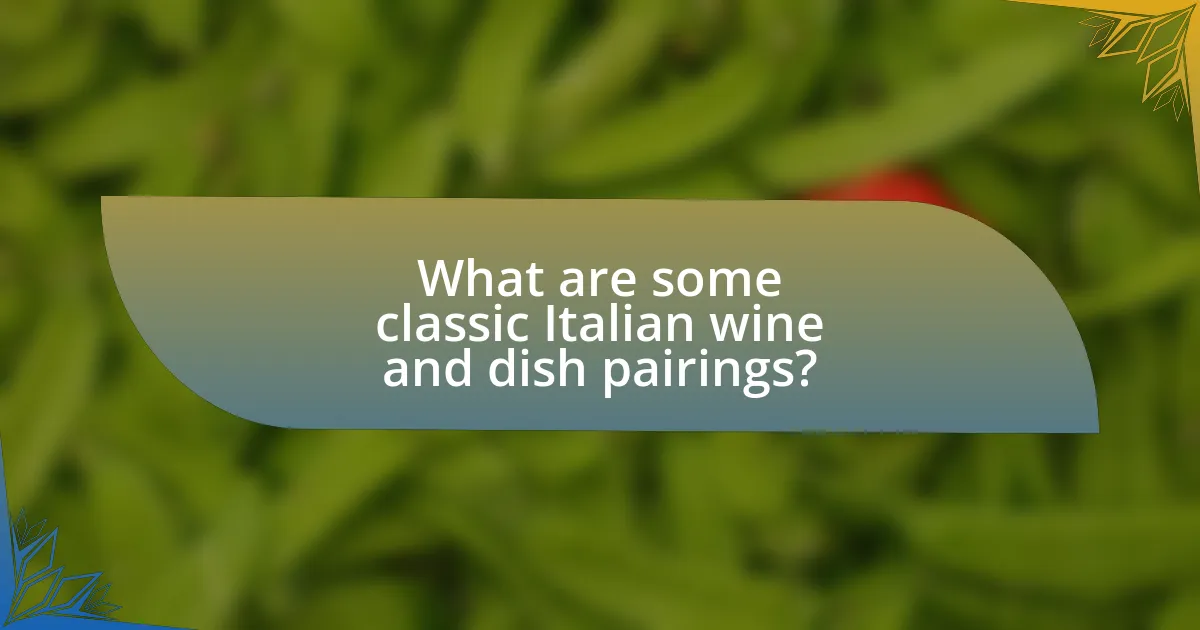The article focuses on the significance of pairing Italian wines with traditional dishes, emphasizing how this practice enhances the dining experience by complementing flavors and textures. It explores the regional diversity of Italian cuisine and wines, detailing how specific wines align with local dishes based on their unique characteristics. Key principles of wine pairing, including the importance of acidity, tannins, and flavor profiles, are discussed, along with practical tips for selecting wines that harmonize with various Italian dishes. Additionally, the article highlights classic pairings and common mistakes to avoid, providing a comprehensive guide for effectively matching Italian wines with food.

What is the significance of pairing Italian wines with traditional dishes?
Pairing Italian wines with traditional dishes is significant because it enhances the overall dining experience by complementing flavors and textures. Italian cuisine is regionally diverse, and each region has specific wines that reflect local ingredients and culinary traditions. For instance, a Chianti from Tuscany pairs well with tomato-based pasta dishes due to its acidity, which balances the richness of the sauce. This practice is rooted in the Italian philosophy of “terroir,” where the wine and food from the same region are believed to harmonize naturally, creating a more authentic and enjoyable meal.
How does wine pairing enhance the dining experience?
Wine pairing enhances the dining experience by complementing and elevating the flavors of both the food and the wine. When a wine is chosen to match a dish, the acidity, tannins, and flavor profile of the wine can enhance the taste of the food, creating a harmonious balance. For example, a high-acid white wine can cut through the richness of creamy pasta dishes, while a tannic red wine can soften the flavors of grilled meats. Studies have shown that proper wine pairing can increase the overall enjoyment of a meal, as it engages the palate and enhances the sensory experience of dining.
What are the basic principles of wine pairing?
The basic principles of wine pairing involve matching the weight and flavor intensity of the wine with the food. For instance, lighter wines complement lighter dishes, while fuller-bodied wines pair well with richer foods. Additionally, acidity in wine can enhance the flavors of food, making it crucial to consider the acidity level of both the wine and the dish. Furthermore, complementary flavors, such as pairing fruity wines with sweet dishes or herbal wines with herbaceous foods, can create a harmonious dining experience. These principles are supported by the idea that balance and contrast in flavors can elevate the overall taste, as noted in various culinary studies.
How do flavors in food and wine interact?
Flavors in food and wine interact through complementary and contrasting characteristics, enhancing the overall tasting experience. When food and wine are paired effectively, the flavors can either amplify each other or create a balance that highlights specific notes in both. For example, a rich, fatty dish like risotto can be complemented by a crisp white wine, which cuts through the richness, while a bold red wine can enhance the flavors of a savory meat dish. Studies in sensory analysis show that the perception of taste is influenced by the combination of aromas and flavors, indicating that successful pairings can elevate the enjoyment of both the food and the wine.
Why is Italian cuisine unique in terms of wine pairing?
Italian cuisine is unique in terms of wine pairing due to its regional diversity and emphasis on local ingredients. Each region in Italy has distinct culinary traditions that reflect its geography, climate, and agricultural products, leading to specific wine pairings that enhance the flavors of traditional dishes. For example, the rich tomato-based sauces of Southern Italy pair well with robust red wines like Nero d’Avola, while the seafood dishes of the coastal regions are complemented by crisp whites such as Vermentino. This regional specificity is supported by Italy’s long history of winemaking, with over 350 grape varieties cultivated, allowing for a wide range of flavor profiles that align with local cuisines.
What are the regional variations in Italian cuisine?
Italian cuisine exhibits significant regional variations, influenced by local ingredients, climate, and historical factors. For example, Northern Italy is known for its rich, creamy sauces and rice dishes like risotto, while Southern Italy emphasizes tomatoes, olive oil, and pasta, with dishes such as pizza and caponata. The central region, including Tuscany, is famous for its rustic fare, including hearty soups and grilled meats. These distinctions are rooted in the agricultural practices and cultural influences of each area, such as the use of seafood in coastal regions and the prevalence of cured meats in mountainous areas.
How do these variations influence wine choices?
Variations in Italian wines, such as grape variety, region, and production methods, significantly influence wine choices by determining flavor profiles, acidity, and body. For instance, a Chianti from Tuscany typically offers high acidity and cherry notes, making it an ideal pairing for tomato-based dishes, while a Barolo from Piedmont, known for its tannins and complexity, complements rich meats like braised beef. These characteristics guide consumers in selecting wines that enhance the dining experience, as evidenced by studies showing that wine pairing can elevate meal enjoyment and satisfaction.
What are the common types of Italian wines used in pairings?
Common types of Italian wines used in pairings include Chianti, Barolo, Prosecco, and Pinot Grigio. Chianti, a red wine from Tuscany, pairs well with tomato-based dishes due to its acidity. Barolo, known as the “king of wines,” complements rich meats and aged cheeses because of its robust tannins. Prosecco, a sparkling wine from Veneto, is often paired with appetizers and seafood, enhancing the freshness of these dishes. Pinot Grigio, a white wine, is versatile and matches well with lighter fare such as salads and seafood, thanks to its crisp acidity. These wines are widely recognized for their compatibility with traditional Italian cuisine, making them popular choices for food pairings.
What are the characteristics of red Italian wines?
Red Italian wines are characterized by their diverse flavor profiles, acidity levels, and tannin structures, which vary significantly by region and grape variety. For instance, wines like Chianti, made primarily from Sangiovese grapes, exhibit bright cherry flavors and high acidity, making them ideal for pairing with tomato-based dishes. In contrast, Barolo, crafted from Nebbiolo grapes, offers complex aromas of tar and roses, along with robust tannins, suitable for rich meats and aged cheeses. The regional influences, such as climate and soil types, further enhance these characteristics, contributing to the unique identity of each wine.
What are the characteristics of white Italian wines?
White Italian wines are characterized by their diverse flavor profiles, acidity levels, and aromatic qualities. These wines often exhibit crispness and freshness, making them suitable for pairing with a variety of traditional Italian dishes. Common characteristics include fruity notes such as citrus, stone fruits, and floral aromas, which are prominent in varieties like Pinot Grigio and Verdicchio. Additionally, many white Italian wines possess a balanced acidity that enhances their food-pairing versatility, complementing dishes like seafood, pasta with light sauces, and salads. The regional diversity of Italy contributes to the unique characteristics of these wines, with each area producing distinct styles influenced by local grape varieties and terroir.
How can one effectively pair Italian wines with specific traditional dishes?
To effectively pair Italian wines with specific traditional dishes, one should consider the flavor profiles and regional characteristics of both the wine and the dish. For example, a Chianti, known for its acidity and cherry notes, pairs well with tomato-based pasta dishes, as the wine’s acidity complements the acidity of the tomatoes. Similarly, a rich Barolo, with its tannins and earthy flavors, is ideal for hearty meat dishes like osso buco, as the wine’s structure enhances the flavors of the meat. This pairing strategy is supported by the Italian culinary tradition, which emphasizes matching the intensity and flavor components of food and wine.
What are the key considerations when selecting a wine for a dish?
When selecting a wine for a dish, the key considerations include the flavor profile of the food, the wine’s acidity, and the body of the wine. The flavor profile of the dish should complement the wine; for example, rich, hearty dishes pair well with full-bodied wines, while lighter dishes are better suited to lighter wines. The acidity of the wine should match the acidity of the dish; for instance, a high-acid wine can enhance the flavors of a tomato-based sauce. Additionally, the body of the wine, which refers to its weight and fullness, should align with the dish’s richness; a heavier dish typically pairs with a fuller-bodied wine. These considerations are supported by the principle of balance in food and wine pairing, which enhances the overall dining experience.
How do acidity and tannins affect wine pairing?
Acidity and tannins significantly influence wine pairing by affecting the balance and flavor compatibility with food. High acidity in wine enhances freshness and can cut through rich, fatty dishes, making it ideal for pairing with creamy sauces or oily fish. Conversely, tannins, which are compounds found in red wines, provide structure and astringency, complementing protein-rich foods like red meats and aged cheeses. For example, a Chianti, known for its high acidity, pairs well with tomato-based pasta dishes, while a Barolo, rich in tannins, complements grilled meats effectively. This interaction between acidity and tannins with food components is essential for achieving harmonious pairings.
What role does the dish’s preparation method play in pairing?
The dish’s preparation method significantly influences wine pairing by affecting the dish’s flavor profile, texture, and overall intensity. For instance, a dish that is grilled may impart smoky flavors, which can complement a wine with similar characteristics, such as a robust red. Conversely, a dish that is steamed tends to have lighter flavors, making it more suitable for a crisp white wine. Research indicates that the cooking technique alters the chemical composition of the food, which in turn impacts how flavors interact with wine. Therefore, understanding the preparation method is crucial for achieving harmonious pairings that enhance both the dish and the wine.

What are some classic Italian wine and dish pairings?
Classic Italian wine and dish pairings include Chianti with Bistecca alla Fiorentina, Barolo with Osso Buco, and Pinot Grigio with Seafood Risotto. Chianti, a red wine from Tuscany, complements the rich flavors of the grilled T-bone steak, enhancing the dish’s savory profile. Barolo, known as the “king of wines,” pairs well with Osso Buco, a braised veal shank dish, due to its robust tannins and complex aromas that match the dish’s depth. Pinot Grigio, a light and crisp white wine, is ideal with Seafood Risotto, as its acidity balances the creaminess of the dish and highlights the freshness of the seafood. These pairings are rooted in regional traditions and enhance the dining experience by harmonizing flavors.
How do regional dishes influence wine selection?
Regional dishes significantly influence wine selection by dictating flavor profiles and pairing principles that enhance the dining experience. For instance, Italian cuisine varies widely across regions, with dishes from Tuscany often featuring robust flavors that pair well with full-bodied red wines like Chianti, while lighter seafood dishes from coastal regions are complemented by crisp white wines such as Vermentino. This pairing is supported by the Italian tradition of matching local wines with local foods, which has historical roots in the agricultural practices and climate of each region, ensuring that the wine’s acidity, tannins, and flavor notes align with the dish’s ingredients and preparation methods.
What are the best wine pairings for Northern Italian dishes?
The best wine pairings for Northern Italian dishes include Barolo with rich meat dishes, Pinot Grigio with seafood, and Gavi with light pasta dishes. Barolo, made from Nebbiolo grapes, complements hearty dishes like braised meats and truffles due to its robust tannins and complex flavors. Pinot Grigio, known for its crisp acidity, enhances the freshness of seafood, making it ideal for dishes like risotto al nero di seppia. Gavi, a white wine from the Cortese grape, pairs well with lighter pasta dishes and salads, balancing their flavors with its floral and citrus notes. These pairings are rooted in the regional culinary traditions of Northern Italy, where the wine and food often reflect the local terroir.
What are the best wine pairings for Southern Italian dishes?
The best wine pairings for Southern Italian dishes include red wines like Aglianico and Primitivo, as well as white wines such as Greco di Tufo and Fiano di Avellino. Aglianico, known for its bold tannins and dark fruit flavors, complements rich tomato-based sauces commonly found in Southern Italian cuisine. Primitivo, with its jammy fruit profile, pairs well with grilled meats and hearty pasta dishes. Greco di Tufo, characterized by its crisp acidity and mineral notes, enhances seafood dishes and lighter fare, while Fiano di Avellino, with its floral and fruity characteristics, works well with roasted vegetables and creamy sauces. These pairings are supported by the traditional culinary practices of Southern Italy, where local wines are crafted to complement regional dishes.
What are some popular Italian dishes and their ideal wine matches?
Popular Italian dishes and their ideal wine matches include Margherita Pizza paired with Chianti, Spaghetti Carbonara matched with Frascati, and Osso Buco complemented by Barolo. Chianti, a red wine from Tuscany, enhances the tomato and basil flavors in Margherita Pizza, while Frascati, a white wine from Lazio, balances the richness of Carbonara. Barolo, a robust red from Piedmont, complements the savory, slow-cooked flavors of Osso Buco, making these pairings both traditional and harmonious.
How does one pair wine with pasta dishes?
To pair wine with pasta dishes, one should consider the sauce and ingredients of the pasta. For example, tomato-based sauces typically pair well with medium-bodied red wines like Chianti, which complement the acidity of the tomatoes. Creamy sauces, such as Alfredo, are best matched with white wines like Chardonnay, which can balance the richness. Additionally, pesto sauces work well with aromatic whites like Sauvignon Blanc, enhancing the herbal notes. This approach is supported by the Italian tradition of matching regional wines with local dishes, ensuring harmony between flavors.
What wines complement Italian seafood dishes?
White wines, particularly Vermentino and Pinot Grigio, complement Italian seafood dishes effectively. Vermentino, known for its crisp acidity and herbal notes, enhances the flavors of dishes like spaghetti alle vongole (spaghetti with clams). Pinot Grigio, with its light body and citrus notes, pairs well with lighter seafood preparations such as grilled fish or seafood salads. These wines are traditionally chosen in Italian cuisine due to their ability to balance the brininess of seafood, making them ideal companions for various seafood dishes.

What tips can enhance your wine pairing skills?
To enhance your wine pairing skills, focus on understanding the fundamental principles of flavor compatibility. Pair wines with dishes that share similar flavor profiles; for example, a rich, full-bodied red wine complements hearty meat dishes, while a crisp white wine pairs well with lighter seafood. Additionally, consider the acidity and tannin levels in both the wine and the food; high-acid wines can balance fatty dishes, while tannins in red wines can soften the texture of protein-rich foods. Research indicates that matching the intensity of the wine with the dish enhances the overall dining experience, as supported by studies from the Journal of Wine Research, which highlight the importance of balance in flavor profiles for optimal pairing.
How can one develop a personal wine palate?
To develop a personal wine palate, one should engage in regular tasting of various wine styles and varietals. This process involves sampling wines from different regions, grape varieties, and production methods to identify personal preferences. Research indicates that repeated exposure to diverse wines enhances sensory perception and helps individuals discern flavors and aromas more effectively. For instance, a study published in the Journal of Wine Research highlights that systematic tasting can significantly improve wine appreciation and knowledge. By keeping a tasting journal to note preferences and observations, individuals can refine their palate over time, leading to a more personalized wine experience.
What resources are available for learning about wine pairing?
Books, online courses, and websites are valuable resources for learning about wine pairing. Notable books include “The Wine Bible” by Karen MacNeil, which provides comprehensive insights into wine characteristics and pairing principles. Online platforms like MasterClass offer courses taught by experts, such as the wine pairing class by James Suckling. Additionally, websites like Wine Folly provide interactive guides and infographics that simplify the pairing process, making it accessible for beginners and enthusiasts alike. These resources collectively enhance understanding of how to effectively pair Italian wines with traditional dishes.
How can experimentation improve your pairing skills?
Experimentation enhances pairing skills by allowing individuals to discover unique flavor combinations that traditional methods may overlook. Engaging in trial and error with various Italian wines and traditional dishes enables a deeper understanding of how different tastes interact, leading to more personalized and enjoyable pairings. Research indicates that sensory exploration, such as tasting different wine and food combinations, can significantly improve one’s palate and pairing confidence, as evidenced by studies in culinary arts that emphasize the importance of experiential learning in developing taste preferences.
What common mistakes should be avoided in wine pairing?
Common mistakes to avoid in wine pairing include ignoring the weight and intensity of both the food and the wine, which can lead to an unbalanced experience. For instance, pairing a light-bodied wine with a rich, heavy dish can overshadow the wine’s flavors. Additionally, overlooking acidity levels can result in a mismatch; high-acid wines complement fatty foods, while low-acid wines may clash. Another mistake is not considering regional pairings; traditional Italian wines often pair best with local dishes, enhancing the overall dining experience. Lastly, assuming personal preference is universal can lead to poor choices; what one person enjoys may not work for another, so it’s essential to consider the specific flavors and textures of the dish.
How can one avoid overthinking wine choices?
To avoid overthinking wine choices, one should simplify the selection process by focusing on a few key factors such as the dish being served, personal taste preferences, and the wine’s characteristics. By matching the wine to the main ingredients of the dish, individuals can make quicker decisions; for example, pairing a light white wine with seafood or a robust red with red meat. Research indicates that limiting options can reduce decision fatigue, allowing for a more enjoyable experience. A study published in the Journal of Consumer Research found that having fewer choices leads to greater satisfaction in decision-making, reinforcing the idea that simplicity can enhance the wine selection process.
What are the pitfalls of following rigid pairing rules?
Following rigid pairing rules can lead to missed opportunities for flavor enhancement and personal enjoyment. Strict adherence to these rules often ignores individual taste preferences and the complexity of flavors in both wine and food. For instance, a wine that is deemed unsuitable by traditional standards may complement a dish exceptionally well based on personal palate or specific preparation methods. Additionally, rigid rules can stifle creativity and exploration in wine pairing, limiting the experience to conventional combinations rather than encouraging experimentation that could yield delightful surprises.
What practical tips can help in pairing Italian wines with traditional dishes?
To effectively pair Italian wines with traditional dishes, consider the principle of matching the weight and flavor intensity of the wine with that of the food. For example, robust red wines like Barolo complement hearty dishes such as osso buco, while lighter whites like Pinot Grigio pair well with seafood pasta. Additionally, regional pairings enhance the dining experience; for instance, Chianti is traditionally served with Tuscan dishes like ribollita. This approach is supported by the Italian culinary tradition, which emphasizes local ingredients and flavors, ensuring that the wine enhances rather than overwhelms the dish.















